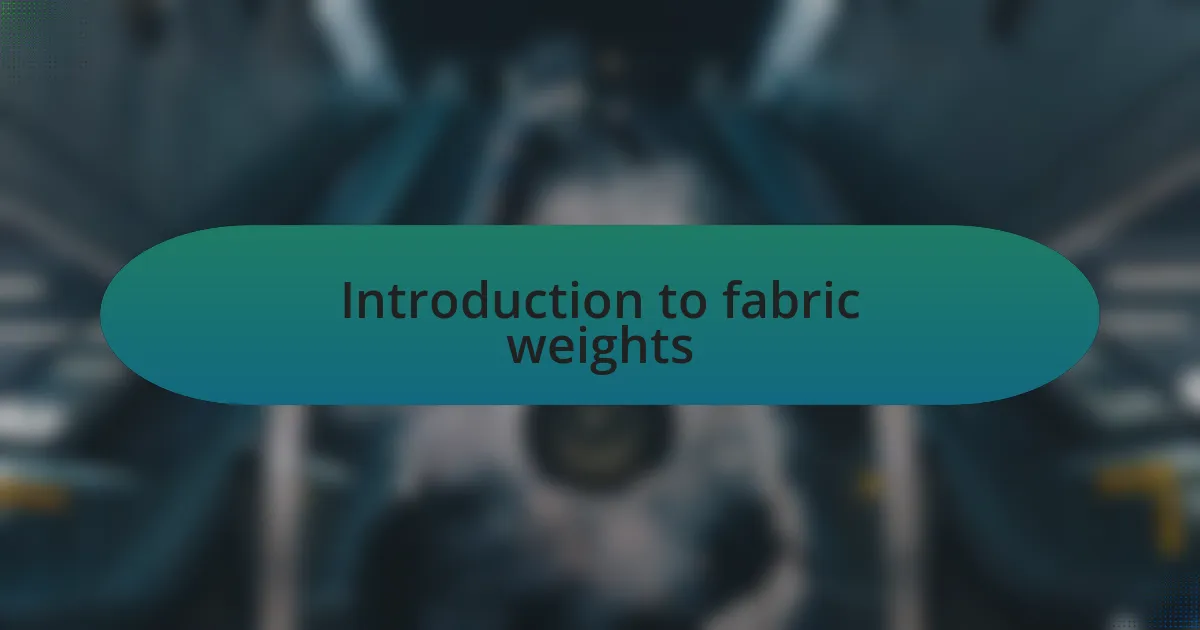Key takeaways:
- Understanding fabric weights is crucial for influencing the look, durability, and comfort of garments.
- Lightweight fabrics provide fluidity but may lack coverage, while heavyweight fabrics offer structure but can restrict movement.
- Choosing the right fabric weight involves matching it to the garment’s purpose and testing its feel and drape.
- Medium-weight fabrics serve as a versatile option, balancing durability and comfort for various projects.

Introduction to fabric weights
Understanding fabric weights is essential for anyone venturing into fashion design. When I first started sewing, I remember being overwhelmed by the sheer variety of materials available. Each weight—be it lightweight like chiffon or heavyweight like denim—dictates how a garment will drape, move, and ultimately wear.
As I explored different fabrics, I found myself questioning: why does it matter so much? Fabric weight influences not just the look of a piece, but also its durability and comfort. I often gravitated toward heavier fabrics for their structure, but I quickly learned that lighter options offered a fluidity that could enhance the overall design.
Diving deeper into fabric weights opened my eyes to the complexities of textile choices. I discovered that understanding grams per square meter (GSM) can be a game-changer—this measure gives you a tangible idea of how fabric will perform. Now, when I’m selecting materials, I find myself analyzing their weights instinctively, knowing it can make or break my design vision.

Different types of fabric weights
When we talk about lightweight fabrics, I instantly think of my first dress made from cotton voile. Its airy feel and gentle drape made it perfect for summer, but I quickly realized that its sheer quality could also lead to transparency issues. Have you ever had a project that didn’t turn out quite like you envisioned? Sometimes, I found myself wishing I had chosen a slightly heavier fabric for more coverage while still maintaining that sought-after lightness.
On the other end of the spectrum, heavyweight fabrics like denim have a beauty all their own. I remember the satisfaction of crafting my first pair of jeans; the sturdy feel brought such confidence and structure to the final piece. There’s an undeniable allure to heavy fabrics—they can give garments a polished look. But the challenge lies in their bulkiness which, while offering durability, can restrict movement. Have you ever struggled with how to incorporate such textures into your designs effectively?
Medium-weight fabrics create a sweet spot for versatility in fashion design, bridging the gap between the extremes. I often turn to canvas or lightweight twill for projects that require durability without the weighty feel—perfect for bags and jackets. I vividly recall a project where I used cotton twill for a structured blazer, allowing for both comfort and style. It made me realize that finding the right balance often leads to the most successful designs. How do you navigate the fabric weight choices in your own projects?

How to choose fabric weights
Choosing the right fabric weight for your project can significantly influence the final outcome. When I started crafting my first tailored jacket, I initially chose a heavy wool. While it felt luxurious, I quickly discovered it was too stiff for what I envisioned. Have you ever faced a situation where your fabric just didn’t cooperate? It’s essential to match the weight to the garment’s purpose—lighter weights work beautifully for flowing skirts, while heavier options provide the structure needed for crisp jackets.
I often recommend conducting a “weight test” before committing to a fabric. Simply hold the fabric in your hands—does it feel right for your project? I remember when I was unsure about a linen blend for a summer top. After a bit of tugging and draping, I found it resilient yet comfortable enough to breathe during those hot days. The tactile experience was invaluable; it made me appreciate how much a fabric’s weight can enhance a design.
Lastly, consider the drape of the fabric, as it plays a crucial role in how the garment moves. I learned this lesson the hard way when I used a medium-weight fabric for a fitted dress that needed more fluidity. The result was unexpectedly awkward! Have you experimented with varying weights to achieve the desired drape? Balancing these elements ensures your design has both the visual appeal and functionality you want.